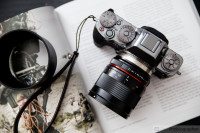
Midrange mirrorless comparison - Nikon's Z50 versus Canon's EOS M6 Mark II Nikon's Z50 and Canon's EOS M6 Mark II are both built around APS-C sized sensors, mirrorless lens mounts, come with twin-dial controls and are being launched at similar prices.
But as much as they have in common, there are plenty of other aspects separating the two as well.
We've gotten a chance to use them both and have a ton of details for you about how they compare, but not just on specs alone. We'll take a closer look at how well they're each work for common photographic use cases.
Features
First things first, the Canon comes with noticeably more resolution than the Nikon: in fact, at 32. 5MP, the M6 Mark II (along with its DSLR sibling, the EOS 90D) comes with the highest-resolution APS-C sensor we've yet seen. The Nikon Z50 instead uses a 20. 9MP unit that is closely related to the one in the Nikon D500. This will be plenty of megapixels for most people, but some users may want more; and we'll have more on that in a bit.
Both cameras have sophisticated on-sensor autofocus systems that offer eye-detection and subject tracking, but they differ greatly in both interface and usability. Most notably, the Z50 has a four-way controller for interacting with your AF point (and there is no way to use the screen as a touchpad with your eye to the finder), while the M6 II makes do with merely a touchscreen.
Both capture full-width 4K video and offer fast burst speeds, but further differences like ergonomic design and their respective lens lineups will have a big impact on which option is the right one for you.
Landscape photography
Canon EOS M6 Mark II | Canon EF-M 22mm F2 | ISO 100 | 1/160 sec | F7. 1
Photo by Richard Butler
Both cameras tick a fair amount of boxes for landscape shooting, albeit different ones. The more compact EOS M6 II is going to be the easier option to pack into a bag for heading out into the elements, though you may want to add on the optional EVF for shooting in bright light.
However, the Nikon Z50's claimed weather sealing is probably going to help it stand up to those elements better if you're expecting inclement weather, and its larger grip, buttons and dials will be more easily operable with gloves. You can top them up with USB should battery life run down while you're off the grid - and they have similar battery life numbers.
If you like to crop, or you want to make the largest prints you can from an APS-C sensor, the M6 II is your best bet
Based on our testing of cameras with similar sensors, we expect both the Z50 and M6 II to have good dynamic range, so that won't be a big differentiator. But resolution absolutely will be: 32. 5MP is a good amount more than 20. 9MP. So if you like to crop, or you want to make the largest prints you can from an APS-C sensor, the M6 II is your best bet here.
But we must also consider lenses: from our initial photos, we've only seen one native zoom lens that performs well on the high-res M6 II sensor, and that's the wide-angle 11-22mm F4. 5-5. 6. There's a wide suite of primes for the system now, to be sure (more on those later), but for users who work with a more 'standard' zoom range, we think Nikon's Z50 solution may be best.
Of course, you can always adapt lenses from Canon's EF-S and EF mount DSLRs onto the M6 II, and Nikon's Z-mount full-frame lenses and F-mount lenses on the Z50. If you're willing to put up with the extra bulk and cost, either camera will offer you plenty of options.
Travel
Nikon Z50 | Nikon Z DX 16-50mm F3. 5-6. 3 | ISO 100 | 1/640 sec | F6. 3
Photo by Carey Rose
Both cameras will to be great for travelers, for several reasons. Firstly they're both reasonably compact and easy to pack. They both offer USB charging (be aware we think the Canon requires USB Power Delivery spec) so you can top up their batteries on-the-go. They each offer solid Wi-Fi connectivity so you can get images onto your phone and onto the web from just about anywhere.
Oh, and we like the pictures out of each of them: even their un-tweaked JPEGs look to offer pleasing color and will be great for quick social posts. And if you do find you want to tweak your files, each allows for user-friendly creative filters as well as more powerful processing of Raw files right on the camera.
For this use, we wouldn't get too fussed about the standard zooms on either camera - they're both compact, and the Canon offers good-enough sharpness for web posting. But if you want better low light performance or blurrier backgrounds behind your subjects, we'd recommend the EOS M6 Mark II because it has more native, fast-aperture primes available for reasonable prices.
On the Nikon Z50, you can of course adapt Nikon's full-frame Z primes, as well as crop-sensor and full-frame Nikon F-mount primes, but that adds a lot of bulk and, potentially, cost. On the M6 II, you have 16mm, 30mm and 56mm F1. 4 primes from Sigma as well as Canon's 22mm F2 and 32mm F1. 4, and they're all available for less than $500 US each.
We found the original EOS M6 with Canon's 22mm prime was a particularly pleasing combination for travel, and we'd expect the same with the Mark II. But it bears mentioning that if you are shooting in a lot of bright light, you'll want a viewfinder, so if you get your EOS M6 II with the optional unit, don't forget to bring it along.
Sports and action
Canon EOS M6 Mark II | Canon EF-M 18-150mm F3. 5-6. 3 | ISO 100 | 1/250 sec | F9
Photo by Carey Rose
Sports and action shooters eyeing either of these cameras will find that they look awfully capable from their specifications. The Nikon Z50 doesn't shoot quite as fast as the Canon M6 Mark II, topping out at 11fps with autofocus to the Canon's 14fps. If you want a live view of images between each of your shots, the Nikon drops to 5fps, which is again slower than the Canon's 7fps.
And all this is ignoring the Canon's very fast 30 fps Raw Burst mode, which is just as it sounds: the camera shoots a burst of Raw images at 30 fps for around three seconds. The caveats with this feature include a 1. 25x crop, as well as the requirement that you 'unpack' the burst using Canon's proprietary software once you download them to your computer, but Canon edges out the Nikon on absolute speed here.
We generally find we prefer a viewfinder to a rear screen when shooting sports and action, and it's no different with these cameras. The Nikon Z50's unit is broadly comparable to the EOS M6 II's detachable unit, so as long as you get the Canon with a kit that includes the EVF-DC2, you won't be left wanting.
Both cameras comes with adept on-sensor phase detection systems capable of accurately following subjects very well
But burst speeds are meaningless if none of your images are in focus. Luckily, both cameras comes with adept on-sensor phase detection systems capable of accurately following subjects very well, particularly if you choose a 'zone' and keep it over your subject on your own. If you want the camera to track your subject for you around the frame, the Nikon requires a series of button clicks to get there , whereas the Canon requires you to change one menu setting, and thereafter, you only need a half-press of the shutter once you find your intended subject.
Lastly, ergonomics bear mentioning. The Nikon's dedicated four-way controller makes moving your AF point a more tactile experience than the M6 II's touchscreen (though the latter isn't bad by any means), and the Nikon's larger grip will be more comfortable if you're adapting larger telephoto zooms. But if you opt for each system's native, lightweight telephoto zooms (meaning Nikon's DX Z 50-250 F4. 5-6. 3 or Canon's EF-M 55-200mm F4. 5-6. 3), either camera will balance just fine.
Family and moments
Canon EOS M6 Mark II | Canon EF-M 22mm F2 | ISO 100 | 1/320 sec | F3. 2
Photo by Richard Butler
To start, just as both cameras' autofocus systems are capable with sports and action, they're quite good at focusing on people as well. Both come with reliable eye-detection autofocus, ensuring focus is exactly where you want it. The M6 II has the edge again here: if for some reason it loses track of your subject, or that person turns away, the camera won't jump to someone else, as the Nikon Z50 will.
Both kit lenses are going to be great for general outdoor shooting, but if you're out at a fancy candlelit dinner, you'll want a fast prime lens for the best images, and Canon simply has better options here, as we covered in the 'Travel' section.
Image quality on both cameras is generally superb. This means you will rarely have to tweak images before sending them off to your phone, which you can then easily share with the people around you, in the moment.
Without its viewfinder, the M6 II is a bit easier to throw into a bag than the Z50, but once attached, the size difference between the two is less significant. And since both can be USB charged, you can use the same USB Power-Delivery charger you use for your phone to keep them topped up should you run out of power.
Lifestyle and people
Nikon Z50 | Nikon Z 50mm F1. 8 S | ISO 100 | 1/4000 sec | F1. 8
Photo by Chris Niccolls
While family and moments is primarily about casual outings, this type of photography is for the social media conscious photographer looking to add some panache to a scene with some posing and creative use of depth-of-field.
To summarize, both cameras are capable of great image quality out-of-camera despite their small size, and each have great eye-detection focus (though we prefer generally the Canon's). Both let you get your images onto the social web quickly, but you can tweak them on the cameras themselves before getting them to your favorite image-sharing app.
As with a few of the previous categories, it really comes down to lenses here. Between Canon's own primes and now Sigma's, the EOS M6 Mark II has a pretty extensive range of fast prime lenses that are both appropriately sized and priced for the camera. Nikon's only two native Z-mount crop-sensor lenses are currently kit zooms, and their slower variable apertures won't blur backgrounds as well. Add a full-frame Z mount prime, or any F-mount prime and an adapter, and you're spending more money and adding more size and weight.
Video
These cameras offer comparable video feature sets. They each provide 4K video from the full width of the sensor and have microphone and micro-HDMI ports, but no headphone port to monitor audio. The tilting touchscreens make it easy to shoot from odd angles, but hand-held footage has to rely on in-lens stabilization as neither has a stabilized sensor in the camera body. Our biggest concern was the lack of 24p video recording from the Canon, but the company says it's adding it in a firmware update in 2020.
The Nikon gives you more flexibility for configuring a separate i (custom) menu for video mode and they both allow you to set up separate button functions when video shooting.
Additionally, both cameras feature face-and-eye-detect autofocus while shooting video, as well as tap-to-track functionality. In all, they're both solid options for shooting good-quality, casual video.
The wrap
Throughout this article, there are some themes that have emerged. Both of these cameras are really good cameras that are capable of taking stellar images and video. Both cameras can perform very well with capturing fast action as well as photographing human subjects.
They both handle very well, but differently, and this will come down to personal taste for many people. The larger grip of the Z50 lends itself better to larger lenses, which may be welcome if you're adapting lenses from the company's other lens mounts. Which brings us to the largest theme so far.
There are currently more native EF-M zooms and primes available than there are for the Z50
It's true that vast majority of buyers aren't likely to move too far beyond the kit lenses on either of these cameras, but the EOS M6 II gives you the most cost-effective and size-conscious options to do so, if you ever decide to. There are currently more native EF-M zooms and primes available than there are for the Z50, and native lens options are likely to be a less confusing path to navigate for new users than deciphering adapters, additional mounts, autofocus motor compatibility, and so on.
Of course, it could be argued that buying full frame Z-mount lenses puts you on a full-frame upgrade path on the Nikon – a path that doesn't exist for the Canon. But the affordability of the EF-M prime lenses means it might be more cost-effective to choose what you need now rather than compromising in anticipation of a switch you might make at some later date.
But what about you? What do you make of these two cameras and how would you use them? Let us know in the comments.
. dpreview.com2019-11-11 17:00














